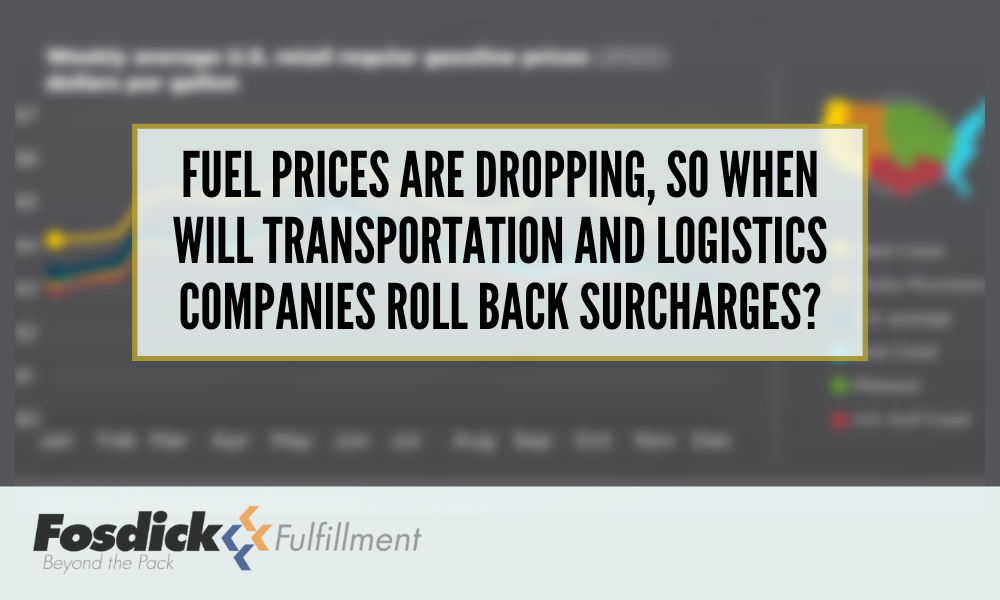From the US Energy Information Administration:
Rising crude oil prices and increased gasoline demand early in 2022 contributed to rising US retail gasoline prices in the summer. but gasoline prices ended 2022 lower than at the start of the year because of more refinery production and less demand during the second half of the year.
According to the EIA’s record of domestic fuel costs, 2022 began with an average retail price per gallon of $3.28. This was also the lowest of the year. Prices steadily increased throughout January and February, reaching a high of $5.00 in early June.
But at some point just before the summer surge, the industry was a-buzz over fee structures meant to account for fuel costs. Of particular interest to brands and 3pls is the rollout of indexed fuel surcharges attached to small parcel postage rates.
In March, Nexstar reported FedEx’s plan to raise its fuel surcharge for all three shipping services: Express, Ground, and Freight. The new price ranges went into effect on April 4 of last year.
Fuel surcharges always varied week-to-week based on the price per gallon of diesel. But after April 4th, the entire table was restructured to increase the rate at which fuel would be assessed. For instance, at the time of the change, FedEx Ground’s domestic fuel surcharge was 16.25 percent – a rate reflective of diesel fuel price averages between $5.17 and $5.26. But after the change, those same fuel costs triggered a surcharge of up to 18 percent.
FedEx was not the only one. UPS’ fuel surcharge table mimicked the FedEx model before the change, and after the increases, UPS followed suit. At the time, Josh Dunham, CEO of Reveel Group, a parcel consultancy, said the sharp and sudden spikes would put more pressure on shippers to decide whether to absorb some or all of the increase and how much could be passed on to the end customer without threatening the shippers’ competitive positions. Reveel’s customer base shipping with UPS had seen fuel spending double to more than 10%.
It’s easy to become disenchanted by the seemingly endless parade of added costs, accessorials, and peak fees, but it’s not just the carriers who raised prices to offset fuel in 2022. The truth is, the buck was passed many times, even before it landed at the doorsteps of couriers.
Ocean shipping prices were already rising due to insufficient storage and port capacity. But as global fuel spiked, ocean shipping costs exploded. As with trucking, fuel accounts for most ocean carrier expenses. In an effort to keep profit margins intact, these companies instituted rate increases while also addressing the rising fuel issue head-on.
Slow-steaming describes a tactic wherein ocean-liners reduce speed from the standard 22 knots to 15 knots. The practice certainly cut down on fuel consumption but also added to already slow shipping times.
Air Cargo experienced the most exaggerated fuel increase as jet-fuel prices rose 82% by the spring of 2022. Air shipment was already the most premium way for retailers to bring in new inventory from off-shore manufacturers. For many brands, it was a worthwhile investment to ensure supply was readily available and customer demand met with the quick domestic turnaround. But the cost-effectiveness of air shipping is a fine line, and even minimal price inflation would render the channel no longer viable.
It is also true that many products and goods shipped by air are not loaded onto dedicated flights but rather packed within the belly of passenger planes. The price of jet fuel would lead to prohibitive passenger air travel costs. This also meant less opportunity for air shippers to leverage commercial flights for product transport, further cutting into their bottom line.
These are just a few stops along the supply chain where the impact of fuel cost fluctuation has been detrimental and massively consequential. But there is an operative word amid that last statement – fluctuation. Fast forward to the new year, 2023, and the price has not steadily increased. And it hasn’t just deflated or returned to normal, either. As we mentioned at the start, as of the last week in January, the average cost at the pumps is marginally lower year-over-year, and diesel seems to be trending to follow suit. January’s price per gallon of ultra-low sulfur retail diesel is $4.57, roughly where it stood in March of 2022.
All this begs one interesting and important question – if fuel cost inflation has largely subsided, what will come of widespread fuel surcharge fee structures present at every phase of supply? It would be easy to lose track of time and the events that led to added charges from couriers, freighters, freight haulers, drayers, and the like. For the past year, it was the cost of doing business. Considering the state of international affairs, and the circumstances surrounding global fuel costs, the playing field still felt pretty level. But at some point, as the context changes, residual 2022 fuel surcharges become another layer of profit insulation for transportation and logistics companies. When distributed across varied providers, it becomes likely that somewhere along the line, at least one vendor service, retailer, or end consumer is priced out of the marketplace completely. Exclusive supply chains are expensive, and expensive supply chains are inefficient. The irony is, in our line of work, we can’t afford inefficiency.

